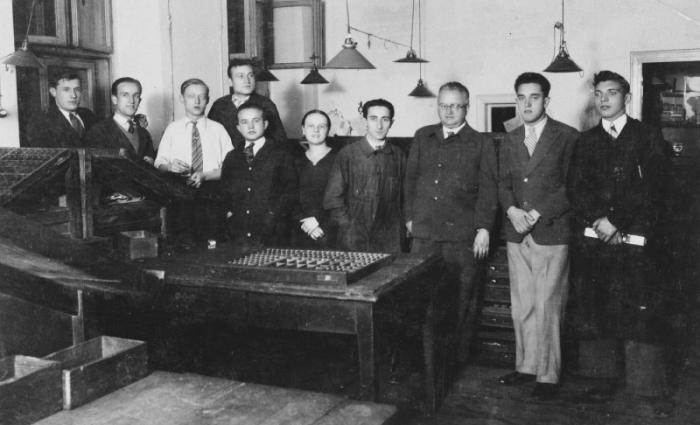
Jewish Community of Kalisz: Economy, Politics, Government
Economy
In the period between World War I and World War II, Kalisz, which had a long history of producing lace and other textiles, became a center for the garment industry. In 1921, of the over 500 Jewish-owned factories and enterprises, 400 produced clothing or textiles (other products included metals, lumber, and leather). Flour from the 12 Jewish-owned mills in Kalisz reached all parts of Poland. There was also a handful of Jewish professionals.
Since Jewish workers constituted 45 percent of all wage-earners in Kalisz, it is not surprising that Jews played an important role in the town's trade unions. Some of the unions were open to all: the Embroiderers' Union had Polish, Jewish, and German members. Other unions were more segregated: the Garment Union organization had only Jewish members, and Polish tailors and garment workers belonged to the Polish Craftsmen Society. Jewish unions included associations of leather workers, clerks, porters, and female domestic workers. The latter advocated for the rights of young women who came to Kalisz from small towns and who were often subject to the whims of their employers. The association for female domestic workers helped to ensure fair treatment, decent wages, and a rest day on the Sabbath.
The two Jewish financial institutions established after World War I, the Merchants' Bank and the Cooperative Bank, failed during the Depression. As the economy deteriorated—and as the Polish government continued to adopt anti-Jewish economic policies—many industrial workers were forced into petty commerce or peddling with few prospects for a meaningful livelihood. As was the case in Jewish communities throughout Poland, the Kalisz Jewish community founded cooperative credit and banking institutions to assist the impoverished Jewish population.
Government
The kehillah, or official governing body for the Jewish community, was dominated by the ultra-Orthodox Agudah political party. It administered the Jewish welfare institutions of Kalisz: old-age home, Talmud Torah (school for poor children), orphanage, Jewish hospital (founded in 1835), and free clinic. The kehillah also oversaw the ritual bath and the two yeshivahs in the town, "Magen Avraham" and "Etz Hayyim."
The traditionalist Agudah majority of the kehillah faced various challenges during the interwar period, including a boycott of kosher slaughterers organized by the Zionist opposition members in order to cut off the tax revenue that was the mainstay of kehillah income. That income was declining anyway, as the economic situation of the Jews of Kalisz deteriorated. From 1932 to 1935, revenues decreased by 30 percent.
Politics
As was true throughout much of interwar Poland, Jewish life in Kalisz was heavily politicized. The non-Zionist, ultra-Orthodox Agudah boasted one of the strongest local branches in the country, with separate Workers of Agudah and Daughters of Agudah associations established in 1928. Zionism was an important influence as well. In 1920, a public celebration in honor of Britain's acceptance of the Palestine mandate was attended by thousands, and many offered contributions for the purchase of land in Palestine.
The socialist Zionist party Poale Zion sponsored a "Worker's Home" club, which organized lectures, Hebrew classes, and performances and offered a library and reading room to members. In 1900, a branch of the secular Jewish socialist Bund was founded in Kalisz. Jews were also active in general political life, with eleven Jewish residents elected to the municipal council as late as 1939.
Critical Thinking Questions
- Learn about the history of the Jewish community in your country.

